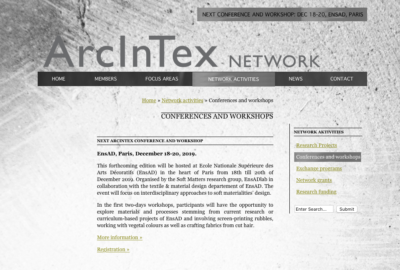06.12.2019
ArcInTex network meeting on science-design relationships – ENSAD – 18-20 décembre 2019
ENSAD is delighted to welcome the next ArcInTex meeting – International academic network dedicated to the intersections between Architecture, Interaction Design and Textile- from 18 till 20th of December 2019.

The morning of the 20th of December (9h30-13h) will be dedicated to a conference on the relationships between science and design. The afternoon will be dedicated to the presentation of the workshops results. Detailed programme and registration (free but compulsory) of this event organized by the Soft Matters research group, Ensadlab: http://arcintex.hb.se/conferences-workshops/ NB: English will be the langage of the event.
Symposium:Soft Matter(s): Sciences-Design junctions & frictions
In its simplest articulation, design’s activity is concerned with how ideas are embodied into the material world. As such defined, design is not the privilege of specific professionals but of any thinker translating abstract ideas into a material reality. Since the industrial revolution, design has however become a profession in its own right related to a set of activities engaged in the imagination, drawing and prototyping of artefacts and the planning of their production. Materials and techniques are today acknowledged as a fundamental part of this intellectuality. Besides, the term materiality is increasinlgy used to refer to this specific stage of material transformation induced by architects and designers, after matter or raw materials being transformed through specific cycles of production, transformation and distribution often led by material science & engineering.
While designers, material scientists and engineers share a common interest in practice-based and experimental approaches to research, these different actors of material creation usually apprehend materials in distinct ways. If material scientists understand them as an outcome of their research process, materials are often a starting point of the design process. While material science focuses on molecular structures to distinghuish why a material is different from another, engineering is preoccupied with the performance of the material at the scale of the object within a given environment. As for designers, their knowledge of materials is traditionnally oriented by their sensorial properties and their context of use.
At a time where ecological challenges require a radical renewal of material practices, this seminar proposes to explore the relationship between design, science and engineering through the prism of material innovation. By bringing an interdisciplinary array of speakers, it will be the occasion to discuss the desired and unexpected frictions and junctions between design and science research practices and question how interdisciplinary collaborations across these disciplines can contribute to the shaping of new sustainable materialities.
• what makes a successful science-design collaboration and how does it lead to the shaping of more sustainable materialities?
• What are the main challenges faced by such collaborations?
• Can textile be a privileged medium to encourage innovation across science and design? How?
By questioning the boundaries between science and design, we ask how more integrative material practices can be fostered for the shaping of more resilient futures and aim at encouraging such dialogue.
Speakers:
• Emmanuel Mahé, Head of research & Ensadlab, Ecole Nationale Supérieure des Arts Décoratifs, Paris
• Agnès Laboudigue, Assistant research director, in charge of Carnot M.I.N.E.S (subject to approval)
• Philippe Vroman Gemtex lab., Ecole Nationale Supérieure des Arts et Industries Textiles, Roubaix
• Emile de Visscher,post.doc, Matter of activities cluster, Humboldt University, Berlin
• Aurélie Mosse, co-head of Soft Matters, Ensadlab, Ecole Nationale Supérieure des Arts Décoratifs, Paris
• Martyn Dade Robertson, Prof. of Emerging Technology, Co-Director of the Hub for Biotechnology in the Built Environment, Newcastle University